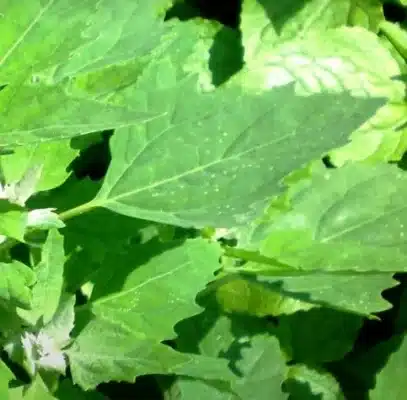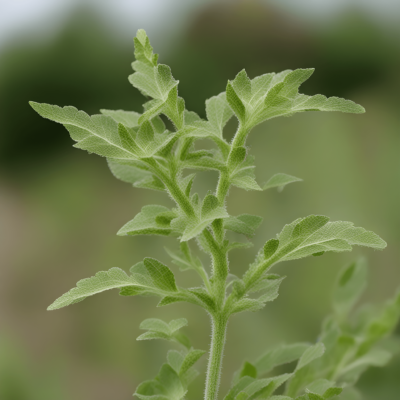Chenopodium album has many common names, like White Geese Foot including/Bathua in Hindi & Chakravarthi Keerai in Tamil- The Wonders of Origins, Uses, and Benefit


Table of Contents
Intro
Intro
White Goose Foot,” also known as Bathua (Chenopodium album) in Hondi and Chakravarthi in Tamil in India, has its origins, nutrient profile, and culinary significance. It belongs to the Amaranth family and is found worldwide in hot regions.
This annual plant belongs to the Amaranthaceae family and is often considered a weed in agricultural settings. It is known by various common names, including lamb’s quarters, pigweed, and goosefoot. Despite its status as a weed, white goosefoot has a long history of human consumption and has been used as a leafy vegetable in various culinary traditions around the world. Its leaves are edible and rich in nutrients, making it a valuable and versatile plant in both traditional and modern cuisines.
White goosefoot is a highly adaptable plant and can grow in a variety of habitats, including waste areas, disturbed soils, and agricultural fields. It prefers full sun and moist, fertile soils, but it can tolerate partial shade and a range of soil types.
The leaves of white goosefoot are triangular or ovate in shape and resemble a goose’s foot, hence the common name. The leaves are covered in a white, powdery substance, which gives the plant its distinctive appearance.
Origin
Origin:
White Goose Foot, is native to Europe and Asia no one knows where exactly it originated from but some even say South America and some say in Africa but it has spread to many parts of the world and can now be found on virtually every continent as far as I researched it, and found it originated in India and Pakistan and has been a part of traditional Indian cuisine for centuries. As it is believed to have originated in India and is widely cultivated throughout the country. It is known for its resilience and ability to grow in various climates, making it a valuable leafy green vegetable in Indian agriculture.
Here are some specific examples of goosefoot leaves being cultivated in ancient times:
The exact origin of white goosefoot (Chenopodium album) is unknown, but it is thought to have originated in Europe and Asia. It has been cultivated as a food crop for centuries, and it has been introduced to many other parts of the world.
The first written record of white goosefoot is from the 1st century AD, when it was mentioned by the Roman naturalist Pliny the Elder. It was also mentioned by the Greek physician Dioscorides in the 1st century AD.
White goosefoot was introduced to North America by European settlers in the 17th century. It quickly became a common weed in many parts of the continent.
In Europe, the Yamnaya culture harvested white goosefoot (Chenopodium album) as a cereal substitute around 3500-2500 BC.
In China, goosefoot leaves were cultivated as a food crop as early as 2000 BC.
In the Americas, quinoa was cultivated by the Incas and other indigenous peoples for centuries before the arrival of Europeans.
Goosefoot leaves are still a popular food source today, and they are eaten in many different cultures around the world.

Nutrients
Nutrient Profile
White Goose Foot, is celebrated for its exceptional nutrient content, offering a wide range of vitamins, minerals, and other beneficial compounds:
Vitamins: Its leaves are particularly rich in vitamins A and C. Vitamin A, in the form of beta-carotene, is essential for vision and immune health, while vitamin C is a potent antioxidant that supports the immune system and skin health.
Minerals: This leafy green provides essential minerals such as calcium, iron, potassium, and magnesium.
Antioxidants: Goosefoot contains various antioxidants, including flavonoids and polyphenols, which help protect cells from oxidative damage.
Fiber: Its leaves are a good source of dietary fiber, promoting digestive health and aiding in weight management.
Protein: While not as protein-rich as some other leafy greens, still contributes to overall protein intake.
Benefits
Health Benefits
Rich in Vitamins: Goosefoot is a potent source of vitamins, particularly vitamin A and vitamin C. Vitamin A is essential for good vision and a robust immune system, while vitamin C acts as a powerful antioxidant, supporting immune function and promoting skin health.
Mineral-Rich: Contains essential minerals like calcium for strong bones, iron for oxygen transport, potassium for maintaining healthy blood pressure, and magnesium for various bodily functions.
Antioxidant Protection: The antioxidants in goosefoot, includes flavonoids and polyphenols, help protect cells from oxidative damage and may reduce the risk of chronic diseases.
Dietary Fiber: Its leaves are a good source of dietary fiber, promoting digestive regularity and aiding in weight management.
Protein Source: While not as protein-rich as some other leafy greens, Bathua still contributes to overall protein intake, making it a valuable plant-based protein source.
Digestive Health: The fiber content supports healthy digestion and may help alleviate constipation.
Immune Support: High vitamin C content in Bathua enhances immune function, aiding the body’s defense against illnesses.
Heart Health: White Goosefoot nutrients, particularly potassium, calcium, and antioxidants, may contribute to heart health by reducing cholesterol levels and supporting healthy blood pressure.
Iron Intake: It provides a source of iron, which is crucial for preventing iron-deficiency anemia.
Weight Management: Dietary fiber in White Goosefoot promotes a feeling of fullness, potentially assisting with weight management.
Bone Health: The calcium content supports strong and healthy bones.
Anti-Inflammatory: Some bioactive compounds may help reduce inflammation in the body, potentially benefiting overall health.
Hydration: Its leaves have a high water content, contributing to overall hydration when included in meals.
Consuming Bathua Saag can be a nutritious and delicious way to incorporate vital nutrients into your diet. As with any dietary changes, it’s advisable to consult with a healthcare professional for personalized dietary recommendations, especially if you have specific health concerns or conditions.
Culinary
Culinary Significance
In Indian cuisine, Bathua is a versatile and cherished ingredient. Bathua leaves are used to create a traditional dish known as “Bathua Saag.” This dish is typically prepared by sautéing or boiling the Bathua leaves with spices and seasonings to create a flavorful and nutritious side dish. Bathua Saag is enjoyed with various Indian bread such as roti, paratha, or rice.
Bathua’s role in Indian cuisine extends beyond its delicious flavor; it is also valued for its potential health benefits. Bathua Saag is a nutritious addition to meals, offering both taste and essential nutrients. It is particularly popular during the winter months when fresh greens are in season and provide a valuable source of vitamins and minerals.
White Geese Foot, known as Bathua, exemplifies the close relationship between traditional Indian cuisine and locally available, nutrient-rich ingredients. Its culinary significance and nutrient density make it a beloved leafy green in Indian households, contributing to the overall health and well-being of those who savor it.
